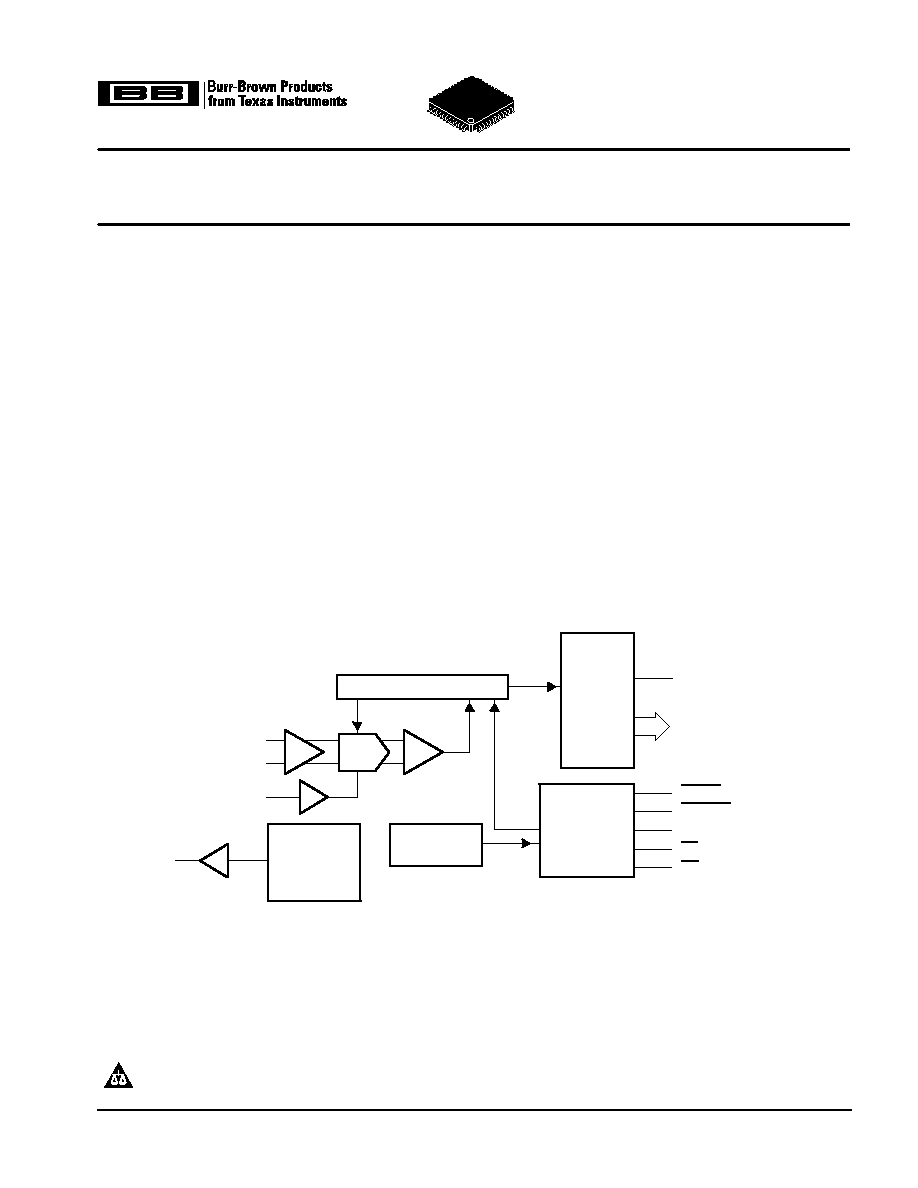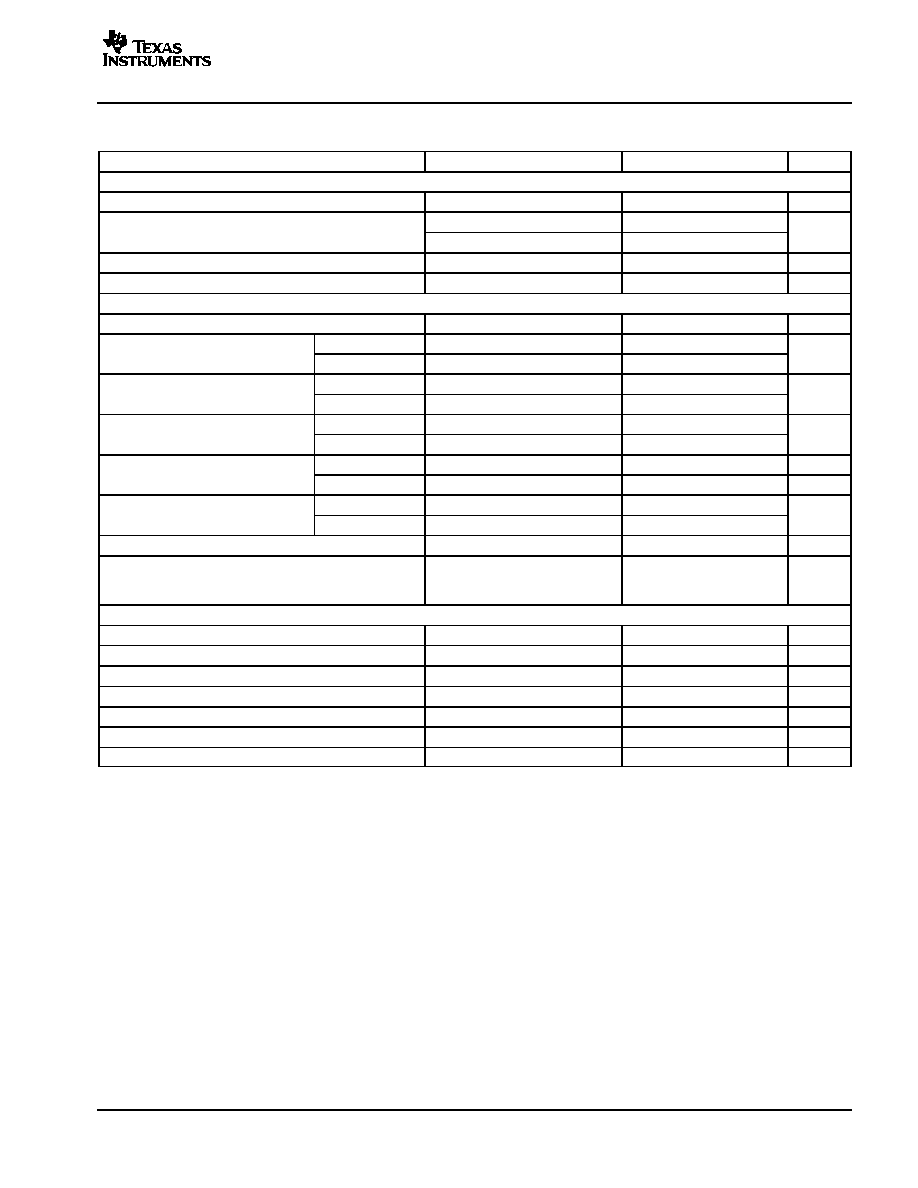
ADS8401
SLAS376B ≠ DECEMBER 2002 ≠ REVISED APRIL 2003
16-BIT, 1.25 MSPS, UNIPOLAR INPUT, MICRO POWER SAMPLING ANALOG-TO-
DIGITAL CONVERTER WITH PARALLEL INTERFACE AND REFERENCE
FEATURES
D
1.25-MHz Sample Rate
D
16-Bit NMC Ensured Over Temperature
D
Zero Latency
D
Unipolar Single-Ended Input Range: 0 V to
V
ref
D
Onboard Reference
D
Onboard Reference Buffer
D
High-Speed Parallel Interface
D
Power Dissipation: 155 mW at 1.25 MHz Typ
D
Wide Digital Supply
D
8-/16-Bit Bus Transfer
D
48-Pin TQFP Package
APPLICATIONS
D
DWDM
D
Instrumentation
D
High-Speed, High-Resolution, Zero Latency
Data Acquisition Systems
D
Transducer Interface
D
Medical Instruments
D
Communication
DESCRIPTION
The ADS8401 is a 16-bit, 1.25 MHz A/D converter with an
internal 4.096-V reference. The device includes a 16-bit
capacitor-based SAR A/D converter with inherent sample
and hold. The ADS8401 offers a full 16-bit interface and an
8-bit option where data is read using two 8-bit read cycles.
The ADS8401 has a unipolar single-ended input. It is
available in a 48-lead TQFP package and is characterized
over the industrial ≠40
∞
C to 85
∞
C temperature range.
CDAC
_
+
Output
Latches
and
3-State
Drivers
BYTE
16-/8-Bit
Parallel DATA
Output Bus
SAR
Conversion
and
Control Logic
Comparator
Clock
+IN
≠IN
REFIN
CONVST
BUSY
CS
RD
RESET
4.096-V
Internal
Reference
REFOUT
PRODUCTION DATA information is current as of publication date. Products
conform to specifications per the terms of Texas Instruments standard warranty.
Production processing does not necessarily include testing of all parameters.
Please be aware that an important notice concerning availability, standard warranty, and use in critical applications of Texas Instruments
semiconductor products and disclaimers thereto appears at the end of this data sheet.
Copyright
2002≠2003, Texas Instruments Incorporated

ADS8401
SLAS376B ≠ DECEMBER 2002 ≠ REVISED APRIL 2003
www.ti.com
2
These devices have limited built-in ESD protection. The leads should be shorted together or the device placed in conductive foam during
storage or handling to prevent electrostatic damage to the MOS gates.
ORDERING INFORMATION
MODEL
MAXIMUM
INTEGRAL
LINEARITY
(LSB)
MAXIMUM
DIFFERENTIAL
LINEARITY
(LSB)
NO
MISSING
CODES
RESOLU-
TION (BIT)
PACKAGE
TYPE
PACKAGE
DESIGNATOR
TEMPER-
ATURE
RANGE
ORDERING
INFORMATION
TRANS-
PORT
MEDIA
QUANTITY
ADS8401I
±
6
2 3
15
48 Pin
PFB
≠40
∞
C to
ADS8401IPFBT
Tape and
reel 250
ADS8401I
±
6
≠2~3
15
48 Pin
TQFP
PFB
≠40 C to
85
∞
C
ADS8401IPFBR
Tape and
reel 1000
ADS8401IB
±
3 5
1 2
16
48 Pin
PFB
≠40
∞
C to
ADS8401IBPFBT
Tape and
reel 250
ADS8401IB
±
3.5
≠1~2
16
48 Pin
TQFP
PFB
≠40 C to
85
∞
C
ADS8401IBPFBR
Tape and
reel 1000
NOTE: For the most current specifications and package information, refer to our website at www.ti.com.
ABSOLUTE MAXIMUM RATINGS
over operating free-air temperature range unless otherwise noted(1)
UNIT
Voltage
+IN to AGND
+VA + 0.1 V
Voltage
≠IN to AGND
0.5 V
+VA to AGND
≠0.3 V to 7 V
Voltage range
+VBD to BDGND
≠0.3 V to 7 V
Voltage range
+VA to +VBD
≠0.3 V to 2.5 V
Digital input voltage to BDGND
≠0.3 V to +VBD + 0.3 V
Digital output voltage to BDGND
≠0.3 V to +VBD + 0.3 V
Operating free-air temperature range, TA
≠40
∞
C to 85
∞
C
Storage temperature range, Tstg
≠65
∞
C to 150
∞
C
Junction temperature (TJ max)
150
∞
C
TQFP package
Power dissipation
(TJMax ≠ TA)/
JA
TQFP package
JA thermal impedance
86
∞
C/W
Lead temperature soldering
Vapor phase (60 sec)
215
∞
C
Lead temperature, soldering
Infrared (15 sec)
220
∞
C
(1) Stresses beyond those listed under "absolute maximum ratings" may cause permanent damage to the device. These are stress ratings only, and
functional operation of the device at these or any other conditions beyond those indicated under "recommended operating conditions" is not
implied. Exposure to absolute-maximum-rated conditions for extended periods may affect device reliability.

ADS8401
SLAS376B ≠ DECEMBER 2002 ≠ REVISED APRIL 2003
www.ti.com
3
SPECIFICATIONS
TA = ≠40
∞
C to 85
∞
C, +VA = 5 V, +VBD = 3 V or 5 V, Vref = 4.096 V, fSAMPLE = 1.25 MHz (unless otherwise noted)
PARAMETER
TEST CONDITIONS
MIN
TYP
MAX
UNIT
Analog Input
Full-scale input voltage (see Note 1)
+IN ≠ ≠IN
0
Vref
V
Absolute input voltage
+IN
≠0.2
Vref + 0.2
V
Absolute input voltage
≠IN
≠0.2
0.2
V
Input capacitance
25
pF
Input leakage current
0.5
nA
System Performance
Resolution
16
Bits
No missing codes
ADS8401I
15
Bits
No missing codes
ADS8401IB
16
Bits
Integral linearity (see Notes 2 and 3)
ADS8401I
≠6
±
2.5
6
LSB
Integral linearity (see Notes 2 and 3)
ADS8401IB
≠3.5
±
2
3.5
LSB
Differentiallinearity
ADS8401I
≠2
±
1
3
LSB
Differential linearity
ADS8401IB
≠1
±
0.75
2
LSB
Offset error (see Note 4)
ADS8401I
≠1.5
±
0.5
1.5
mV
Offset error (see Note 4)
ADS8401IB
≠0.75
±
0.25
0.75
mV
Gain error (see Notes 4 and 5)
ADS8401I
≠0.15
0.15
%FS
Gain error (see Notes 4 and 5)
ADS8401IB
≠0.098
0.098
%FS
Noise
60
µ
V RMS
DC Power supply rejection ratio
At FFFFh output code,
+VA = 4.75 V to 5.25 V,
Vref = 4.096 V, See Note 4
2
LSB
Sampling Dynamics
Conversion time
610
ns
Acquisition time
150
ns
Throughput rate
1.25
MHz
Aperture delay
2
ns
Aperture jitter
25
ps
Step response
100
ns
Overvoltage recovery
100
ns
(1) Ideal input span, does not include gain or offset error.
(2) LSB means least significant bit
(3) This is endpoint INL, not best fit.
(4) Measured relative to an ideal full-scale input (+IN ≠ ≠IN) of 4.096 V
(5) This specification does not include the internal reference voltage error and drift.

ADS8401
SLAS376B ≠ DECEMBER 2002 ≠ REVISED APRIL 2003
www.ti.com
4
SPECIFICATIONS (CONTINUED)
TA = ≠40
∞
C to 85
∞
C, +VA = +5 V, +VBD = 3 V or 5 V, Vref = 4.096 V, fSAMPLE = 1.25 MHz (unless otherwise noted)
PARAMETER
TEST CONDITIONS
MIN
TYP
MAX
UNIT
Dynamic Characteristics
Total harmonic distortion (THD) (see Note 1)
VIN = 4 Vpp at 100 kHz
≠93
dB
Signal-to-noise ratio (SNR)
VIN = 4 Vpp at 100 kHz
86
dB
Signal-to-noise + distortion (SINAD)
VIN = 4 Vpp at 100 kHz
85
dB
Spurious free dynamic range (SFDR)
VIN = 4 Vpp at 100 kHz
93
dB
≠3dB Small signal bandwidth
5
MHz
External Voltage Reference Input
Reference voltage at REFIN, Vref
2.5
4.096
4.2
V
Reference resistance (see Note 2)
500
k
Internal Reference Output
Internal reference start-up time
from 95% (+VA), with 1
µ
F storage
capacitor
120
ms
Vref range
IOUT = 0
4.065
4.096
4.13
V
Source Current
Static load
10
µ
A
Line Regulation
+VA = 4.75 ~ 5.25 V
0.6
mV
Drift
IOUT = 0
36
PPM/C
Digital Input/Output
Logic family
CMOS
VIH
IIH = 5
µ
A
+VBD≠1
+VBD + 0.3
L
i l
l
VIL
IIL = 5
µ
A
≠0.3
0.8
V
Logic level
VOH
IOH = 2 TTL loads
+VBD ≠ 0.6
+VBD
V
VOL
IOL = 2 TTL loads
0
0.4
Data format
Straight
Binary
Power Supply Requirements
Power supply
+VBD (see Notes 3 and 4)
2.95
3.3
5.25
V
Power su
ly
voltage
+VA (see Note 4)
4.75
5
5.25
V
+VA Supply current (see Note 5)
fs = 1.25 MHz
31
34
mA
Power dissipation (see Note 5)
fs = 1.25 MHz
155
mW
Temperature Range
Operating free-air
≠40
85
∞
C
(1) Calculated on the first nine harmonics of the input frequency
(2) Can vary
±
20%
(3) The difference between +VA and +VBD should not be less than 2.3 V, i.e., if +VA is 5.25 V, +VBD should be minimum of 2.95 V.
(4) +VBD
+VA ≠ 2.3 V
(5) This includes only VA+ current. +VBD current is typically 1 mA with 5 pF load capacitance on output pins.

ADS8401
SLAS376B ≠ DECEMBER 2002 ≠ REVISED APRIL 2003
www.ti.com
5
TIMING CHARACTERISTICS
All specifications typical at ≠40
∞
C to 85
∞
C, +VA = +VBD = 5 V (see Notes 1, 2, and 3)
PARAMETER
MIN
TYP
MAX
UNIT
tCONV
Conversion time
600
610
ns
tACQ
Acquisition time
150
ns
tpd1
CONVST low to conversion started (BUSY high)
35
ns
tpd2
Propagation delay time, End of conversion to BUSY low
20
ns
tw1
Pulse duration, CONVST low
20
ns
tsu1
Setup time, CS low to CONVST low
0
ns
tw2
Pulse duration, CONVST high
20
ns
CONVST falling edge jitter
10
ps
tw3
Pulse duration, BUSY signal low
Min(tACQ)
ns
tw4
Pulse duration, BUSY signal high
630
ns
th1
Hold time, First data bus data transition (RD low, or CS low for read cycle, or BYTE input
changes) after CONVST low
40
ns
td1
Delay time, CS low to RD low
0
ns
tsu2
Setup time, RD high to CS high
0
ns
tw5
Pulse duration, RD low time
50
ns
ten
Enable time, RD low (or CS low for read cycle) to data valid
20
ns
td2
Delay time, data hold from RD high
0
ns
td3
Delay time, BYTE rising edge
or falling edge to data valid
2
20
ns
tw6
RD high
20
ns
th2
Hold time, last RD (or CS for read cycle ) rising edge to CONVST falling edge
50
ns
tpd4
Propagation delay time, BUSY falling edge to next RD (or CS for read cycle) falling edge
Max(td5)
ns
tsu3
Setup time, BYTE rising edge to RD falling edge
0
ns
th3
Hold time, BYTE falling edge to RD falling edge
0
ns
tdis
Disable time, RD High (CS high for read cycle) to 3-stated data bus
20
ns
td5
Delay time, BUSY low to MSB data valid
0
ns
tsu4
Setup time, BYTE change before BUSY falling edge
2
20
ns
(1) All input signals are specified with tr = tf = 5 ns (10% to 90% of +VBD) and timed from a voltage level of (VIL + VIH)/2.
(2) See timing diagrams.
(3) All timings are measured with 20 pF equivalent loads on all data bits and BUSY pins.




